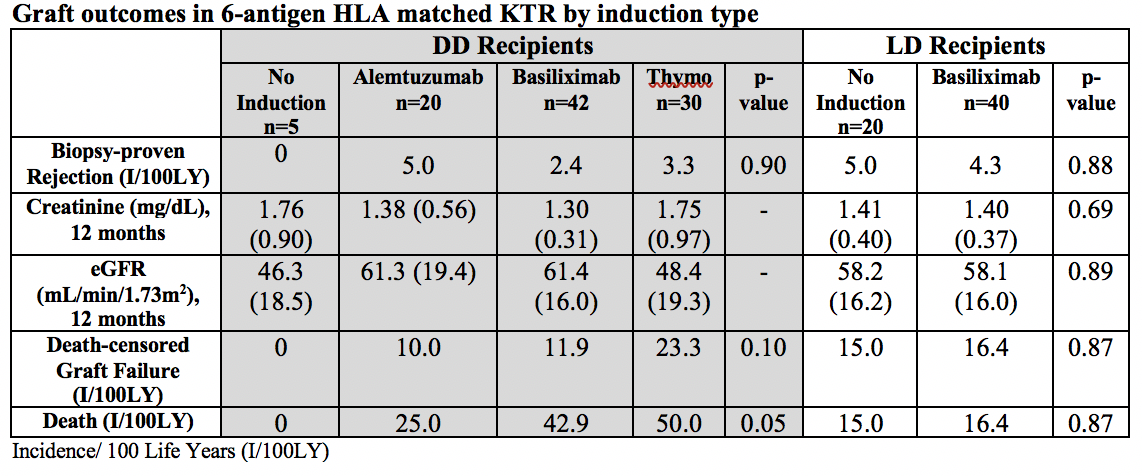Impact of Induction Choice and Early Steroid Withdrawal on Outcomes in HLA Zero Mismatched Kidney Transplant Recipients
1Pharmacy, University of Wisconsin Hospitals and Clinics, Madison, WI, 2Nephrology, University of Wisconsin Hospitals and Clinics, Madison, WI
Meeting: 2019 American Transplant Congress
Abstract number: A234
Keywords: HLA matching, Immunosuppression, Induction therapy, Rejection
Session Information
Session Name: Poster Session A: Kidney Immunosuppression: Novel Regimens and Drug Minimization
Session Type: Poster Session
Date: Saturday, June 1, 2019
Session Time: 5:30pm-7:30pm
 Presentation Time: 5:30pm-7:30pm
Presentation Time: 5:30pm-7:30pm
Location: Hall C & D
*Purpose: Ideal induction and immunosuppression therapy for 6-antigen HLA matched deceased and living kidney transplant recipients (KTR) is not well understood.
*Methods: All 6-antigen HLA matched KTR from 1994-2013 were reviewed to identify outcomes based upon donor deceased status, induction therapy, and steroid continuation (SC) versus early steroid withdrawal (ESW).
*Results: A total of 278 6-antigen HLA matched KTR were identified with 113 from deceased donors (DD) and 165 from living donors (LD). For LD recipients, there was no statistical significance between the no induction group versus induction with basiliximab in rejection (5 vs 4.3, p=0.88), 12-month post-transplant serum creatinine (1.41 vs 1.40, p=0.69), graft failure (15 vs 16.4, p=0.87), or incidence of death (15 vs 16.4, p=0.87). When comparing ESW to SC, there was no difference in incidence of rejection (5.8 vs 2.6, p=0.31), 12-month post-transplant serum creatinine (1.39 mg/dL vs 1.43 mg/dL, p=0.48), or graft failure (13.8 vs 19.2, p=0.60). For DD recipients, incidence of death was highest in the thymoglobulin group (50), compared to no induction (0), alemtuzumab (25), and basiliximab (42.9) (p=0.05). There was no statistical significance between induction type for rejection rates, graft failure, or 12-month post-transplant serum creatinine (see table).
*Conclusions: In patients with 6-antigen HLA matched living donor KTR, ESW is an acceptable maintenance immunosuppression regimen. Induction therapy is not needed in the majority of LD HLA-matched KTR. If induction therapy is required in living donor transplants, basiliximab is recommended due to the low rates of rejection and graft failure. For patients receiving 6-antigen HLA matched deceased donor kidneys, no induction may be considered in low risk patients, however the small sample size (n=5) limits the strength of this recommendation.
To cite this abstract in AMA style:
Votruba C, Holdener K, Astor B, Aziz F, Mandelbrot D. Impact of Induction Choice and Early Steroid Withdrawal on Outcomes in HLA Zero Mismatched Kidney Transplant Recipients [abstract]. Am J Transplant. 2019; 19 (suppl 3). https://atcmeetingabstracts.com/abstract/impact-of-induction-choice-and-early-steroid-withdrawal-on-outcomes-in-hla-zero-mismatched-kidney-transplant-recipients/. Accessed December 17, 2025.« Back to 2019 American Transplant Congress

